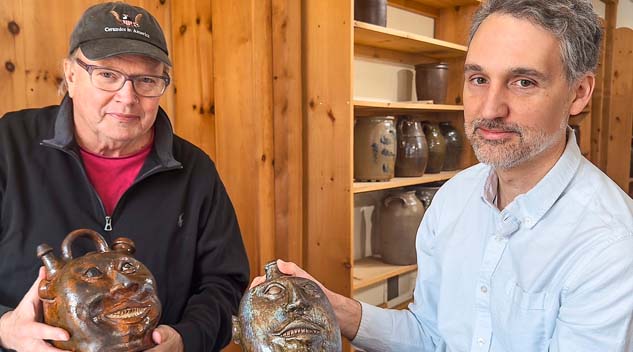
.
.
.
#AntiquesDiscovery #AfricanAmericanPotters #ThomasCommeraw #JohnWesleyPotters #CeramicsResearch #FaceJugs #HistoricalArt #DecorativeArts #SouthernCeramics #BlackCraftsmen #MESDAForum #ArtHistory #CulturalLegacy #AntiquesScholarship #HistoricPreservation
In a groundbreaking discovery that challenges longstanding scholarship in the antiques and ceramics world, Brandt Zipp, partner at Crocker Farm auction house, and Rob Hunter, a ceramics scholar and dealer, have uncovered the true origins of certain face jugs previously attributed to John Wesley, a white potter from Pennsylvania. Their research reveals that these face jugs were instead crafted by an enslaved Black potter in South Carolina. This revelation, presented at the March 14-15 MESDA Southern Ceramics Forum, marks a significant moment in the study of African American ceramics and the history of American decorative arts.
The Backstory of John Wesley
John Wesley was previously known as an obscure potter from Columbia, Pennsylvania, active in the late 19th century. Historical records, including an 1880 federal census, identified him as a Black potter born in South Carolina in 1835. Prior to this discovery, Wesley was largely overlooked in the annals of ceramic history, assumed to be another white craftsman in a region known for its redware production. However, his South Carolina birthplace and the context of his life suggested a deeper story tied to the tradition of enslaved potters in the Edgefield District, South Carolina—a region famous for its African American ceramic artists, including the renowned David Drake, or "Dave."
The Connection to Face Jugs
The face jugs in question are an iconic form of American ceramics, particularly associated with enslaved African American potters in the South. These vessels, often characterized by exaggerated facial features, have long been a subject of fascination and debate among scholars. The discovery of Wesley’s link to these jugs began when Rob Hunter examined a redware face jug in the Colonial Williamsburg collection. This jug, acquired in 1984, bore a striking resemblance to another jug that surfaced in 1993, inscribed with the name "John Westly" and dated 1870. The inscription linked the jug to a potter in Southern Lancaster County, Pennsylvania.
Hunter’s research led him to Brandt Zipp’s work on African American potters, specifically Zipp’s online catalog of Black potters extracted from federal census records. This catalog included John Wesley, a Black potter born in South Carolina and working in Columbia, Pennsylvania, in 1880. The connection between the inscribed jug and Wesley’s documented life suggested that Wesley was the creator of the face jugs previously attributed to a white potter.
The Significance of the Discovery
This discovery is significant for several reasons. First, it sheds light on the life and work of John Wesley, a formerly enslaved potter who established himself as a pottery owner in Pennsylvania—a rare achievement for African American craftsmen of the time. Wesley’s story challenges the assumption that Black potters played minor roles in the development of American ceramics. His decision to produce face jugs in Pennsylvania, a region not known for this tradition, suggests a deliberate effort to market a form with cultural and historical significance.
Second, the attribution of these face jugs to Wesley adds to the growing body of knowledge about African American ceramic artists. For decades, the identities of many enslaved potters were erased by the institution of slavery and historical biases. By identifying Wesley as the maker of these jugs, Zipp and Hunter have restored his legacy and contributed to the broader effort to recognize the contributions of Black craftsmen to American decorative arts.
Third, this discovery has implications for the study of face jugs themselves. The origins, meanings, and uses of these vessels have long been debated. Wesley’s story provides a concrete example of a Black potter continuing the tradition of face jug production in a new context, offering insights into the cultural and economic significance of these objects.
The Research Process
The research process involved extensive examination of historical records, including census data, church records, and auction catalogs. Zipp’s work on African American potters, culminating in his book Commeraw’s Stoneware, provided a foundation for identifying Wesley. Hunter’s expertise in Edgefield ceramics and face jugs helped connect the dots between the jugs and Wesley’s life. Together, they pieced together Wesley’s story, from his origins in South Carolina to his establishment as a potter in Pennsylvania.
One key piece of evidence was the inscription on the jug: "Willa | Frisby | Made by | John Westly | 1870." Through genealogical research, Zipp determined that "Willa Frisby" was likely Aquilla Frisby, a member of the local Mount Zion African Methodist Episcopal Church, where Wesley served as a trustee. This connection strengthened the attribution of the jugs to Wesley and provided a glimpse into his life and community.
Future Directions
This discovery opens doors for further scholarship on African American potters and face jugs. Zipp and Hunter hope that their work will encourage the identification of other forgotten craftsmen and the attribution of more works to specific artists. They also anticipate that Wesley’s story will prompt the discovery of additional examples of his work, including utilitarian pottery and possibly more signed face jugs.
The broader implications of this research extend beyond ceramics. It underscores the importance of revisiting historical records with a critical eye and challenging assumptions about the roles of marginalized groups in American history. By uncovering the stories of African American craftsmen, scholars can give these artists the recognition they deserve and enrich our understanding of American decorative arts.
Conclusion
The discovery of John Wesley’s role in the production of face jugs is a testament to the power of collaborative research and the importance of reexamining historical narratives. By uncovering Wesley’s story, Brandt Zipp and Rob Hunter have not only expanded our knowledge of African American ceramics but also restored the legacy of a forgotten artist. Their work serves as a reminder of the ongoing need to uncover and celebrate the contributions of Black craftsmen to American history and culture. As more discoveries are made, the stories of these artists will continue to reshape our understanding of the past and inspire future generations of scholars and enthusiasts.


